Electronic Variable Optical Attenuators (EVOAs) with Power Lock, Fiber Coupled
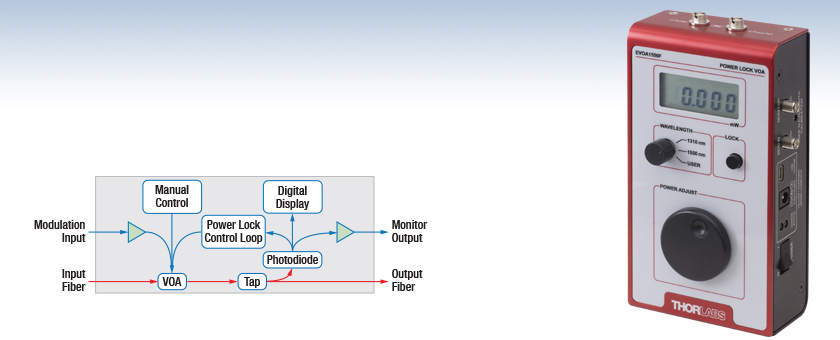
- Manual and Electronic Control of Optical Power in Fiber
- Modulation Input and Monitor Output with 1 kHz Bandwidth
- Power Lock Mode Stabilizes Output for Long-Term Measurements
- Two Wavelength Range Options
Electronic VOA Block Diagram
EVOA1550F
1250 to 1625 nm,
FC/PC Version

Please Wait
| EVOA Quick Links | ||
|---|---|---|
| Item # | Wavelength Range | Connector |
| EVOA800A | 780 - 980 nm | FC/APC |
| EVOA800F | FC/PC | |
| EVOA1550A | 1250 - 1625 nm | FC/APC |
| EVOA1550F | FC/PC | |
| Fiber Optic Attenuator Selection Guide | |
|---|---|
| SM |
Electronic VOAs for System Integration |
| Digital VOAs | |
| Tabletop EVOAs with Power Lock | |
| Manually Variable Attenuators | |
| Fixed-Value Attenuators | |
| MM | Fixed-Value Attenuators |
| Manually Variable Attenuators | |
| PM |
Electronic VOAs for System Integration |
| Manually Variable Attenuators | |
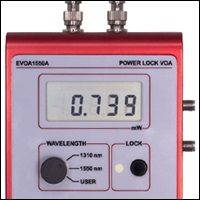
Click for Details
When Power Lock is active, the indicator LED next to the lock button blinks green.
Features
- Wavelength Range Options:
- 780 nm to 980 nm
- 1250 nm to 1625 nm
- Maximum Attenuation Greater than 25 dB Using MEMS-Based Approach
- Input Power up to 200 mW
- In-Line Fiber Optic Power Monitor with Calibrated Reading Displayed
- Power Lock Mode Stabilizes Output When Desired
- Li-Ion Rechargeable Battery with 300 hour Lifetime from Full Charge
Thorlabs' Electronic Variable Optical Attenuators (EVOAs) offer in-line tabletop control of the optical power in a single mode optical fiber, including the ability to lock the optical output power at a user-defined level. These EVOAs provide attenuation of up to at least 25 dB, which can be continuously tuned using either a rotary knob or an external control voltage applied via an SMA connector (maximum frequency of 1 kHz). To attenuate the light, an internal MEMS mirror adjusts the coupling ratio between the input and output fibers. The output power is displayed on the front in mW.
The displayed output power is calculated from the signal read from a low-percentage internal optical tap and wavelength-specific calibration settings. The wavelength selector knob, shown in the photo to the right, is used to choose among one user-calibrated and two factory-calibrated settings. The factory-calibrated settings correspond to 785 nm and 852 nm for the EVOA800 models and 1310 nm and 1550 nm for the EVOA1550 models. The user can also calibrate for any wavelength within the operating range of the EVOA by using a single mode laser, an accurate power meter, and the trimpot on the side utility panel, shown in the photo below. The procedure is described in Section 4.4 of the manuals for the EVOA800 models and EVOA1550 models, and the user's custom calibration setting is accessed by turning the wavelength selector knob to USER.
These EVOAs are designed for use with optical fiber that is single mode within the operating range of the EVOA, and either FC/APC or FC/PC connectors are accepted. An example of single mode optical fiber that may be used with the EVOA800 models is 780HP, while SMF-28 is an option for the EVOA1550 models. For ease of operation, our EVOAs are powered by a Li-ion battery that typically lasts up to 300 hours from a full charge. This battery can be recharged using a USB mini-B connector or the included 5 V power adapter.
Power Lock
Unique to Thorlabs' EVOAs, Power Lock provides automated stabilization of the optical output power. Simply adjust the EVOA to the desired power level and engage the Lock button. This mode has a 1% settling time of <0.5 seconds, making it ideal for correcting slow drifts that occur over long-term measurements. For additional details, please see the Power Lock tab above.

Click to Enlarge
The side of the EVOA provides USB mini-B and power adapter connectors for recharging, two SMA connectors for modulation input and monitor output, and a trimpot for power calibration at user-selected wavelengths.
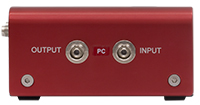
Click to Enlarge
The top of the EVOA contains two bulkheads for FC/PC or FC/APC connectors and a label indicating the connector interface. Four rubber feet prevent the EVOA from sliding when it is lying on a surface.

Janis Valdmanis, Ph.D. Optics
Ultrafast Optoelectronics
General Manager
Got Questions?
Our engineers and expertise are here for you!
If you are not sure whether our catalog items meet your needs, we invite you to contact us. Or ask about a loan, so you can try them out for yourself, in your own lab. We can also support custom or OEM requirements you may have.
Just press the button, and we'll get back to you within the next business day.
| Item # | EVOA800A | EVOA800F | EVOA1550A | EVOA1550F |
|---|---|---|---|---|
| Wavelength Range | 780 to 980 nm | 1250 to 1625 nm | ||
| Fiber Interfacesa | FC/APC | FC/PC | FC/APC | FC/PC |
| Input Power | 200 mW (Max) Absolute Maximum: 250 mW |
|||
| Attenuationb | Minimum: 1.5 dB (Typ.) Maximum: >25 dB |
|||
| Return Loss | ≥40 dB | |||
| Fiber Coupling Loss | 1.0 to 1.5 dB at Each Connector (Typ.) | 0.3 dB at Each Connector (Typ.) | ||
| Digital Display Resolution | 4.5 Digits, Auto-Ranging (Leftmost Digit has a Maximum Value of 1) |
|||
| Digital Display Accuracy | 5% (Typ.) 10% (Max) |
|||
| Calibration Set Points | 785 nm, 852 nm, and User-Defined | 1310 nm, 1550 nm, and User-Defined | ||
| Internal Fiber | 780HP | SMF-28 | ||
| Modulation Input | ||||
|---|---|---|---|---|
| Input Voltage | 0 V to 4.9 V Absolute Maximum: 5.0 V |
|||
| Input Impedance | High Z | |||
| Bandwidth | DC to 1 kHz (Typ.)a | |||
| Connector | Female SMA | |||
| Monitor Output | ||||
|---|---|---|---|---|
| Conversion Gain | 20 mV/mW | |||
| Output Impedance | High Z | |||
| Bandwidth | DC to 1 kHz (Min) DC to 2 kHz (Typ.) |
|||
| Connector | Female SMA | |||
| Battery Specifications | ||||
|---|---|---|---|---|
| Battery Life | 300 h (Typ.) from Full Charge | |||
| Battery Charge | 3000 mAh | |||
| Battery Charging Time | 5 h (Typ.) from 2.1 mm Coaxial Barrel Jack | |||
| Battery Charging Input Power | 5 VDC; Up to 1 A | |||
| Battery Charging Connectors | 2.1 mm Coaxial Barrel Jack (1 A) Female USB Mini-B Connector (Up to 500 mA) |
|||
| Physical Specifications | ||||
|---|---|---|---|---|
| Dimensions | 6.57" x 3.67" x 2.17" (166.9 mm x 93.2 mm x 55.2 mm) |
|||
| Operating Temperature | 10 to 40 °C | |||
| Storage Temperature | 0 to 50 °C | |||
| Relative Humidity | 5% to 85% RH (Non-Condensing) | |||
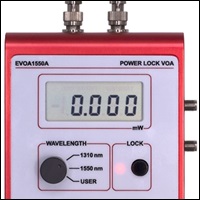
Click for Details
If Power Lock cannot stabilize the input power at the designated setpoint, the indicator LED blinks red.

Click for Details
When Power Lock is active, the indicator LED next to the lock button blinks green.
Power Lock is a unique feature that locks the output power at a user-defined level. When this mode is active, the EVOA will continuously adjust the attenuation in order to keep the output power constant as the input power changes. This is ideal for use in long-term measurements where the optical power needs to be fixed.
When the Lock button is engaged, the Power Lock control circuit will designate the output power on the digital display as the output power setpoint. This circuit has a maximum bandwidth of 1 Hz.
The indicator LED next to the Lock button will flash green intermittently when Power Lock is active and successfully holding the output power constant. If the EVOA loses the lock, then the indicator light will flash red. This typically indicates that the input power has changed significantly enough that the EVOA can no longer successfully compensate. The green and red LEDs are shown in the images to the right.
Power Lock performs best when the input fluctuations are confined to within reasonable limits. In order for it to maintain the output power at the setpoint and respond to changes in input power quickly, the input power must always be greater than the sum of the output power and the EVOA insertion loss. As a rule of thumb, if the input power is at least 2X the output power setpoint, the 1% settling time (i.e., the time until the output power returns to within 1% of the setpoint) is <0.5 seconds, as shown by the plots below. For smaller ratios, the 1% settling time will increase, but the power will still stabilize.
Performance Graphs
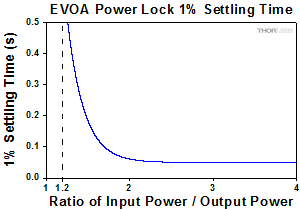
Click to Enlarge
The graph above shows the qualitative behavior of the Power Lock 1% settling time. Power Lock provides fast 1% settling times as long as the input power/output power ratio is at least 2X. As the input power approaches the sum of the output power and the EVOA insertion loss, the settling time will increase, but the power will still stabilize. The asymptote at 1.2X shown above will vary from device to device and is set by the minimum insertion loss (1 dB typical ≈ 20%).
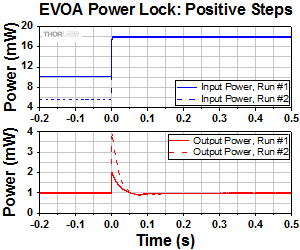
Click to Enlarge
The 1% settling time for an increase in input power is generally short. (This plot contains experimentally measured data, and the output power setpoint was 1 mW.)
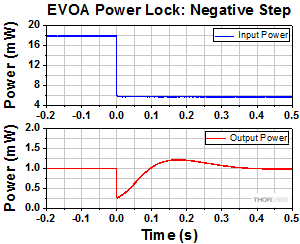
Click to Enlarge
When the input power suddenly drops by a large amount, the 1% settling time increases, but the power still stabilizes. (This plot contains experimentally measured data, and the output power setpoint was 1 mW.)
Modulation Input
SMA Female
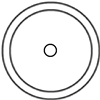
Input Voltage: 0 V to 4.9 V
Input Impedance: High Z
Bandwidth: DC to 1 kHz (Typ.)
Monitor Output
SMA Female

Conversion Gain: 20 mV/mW
Output Impedance: High Z
Bandwidth: DC to 1 kHz (Min); DC to 2 kHz (Typ.)
Charging
USB Mini-B Female
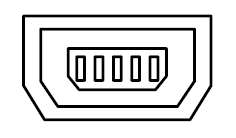
Voltage: 5 VDC
Current: Up to 500 mA; Determined by
Power Source
Charging
2.1 mm Coaxial Barrel Jack

Voltage: 5 VDC
Current: 1 A

Janis Valdmanis, Ph.D. Optics
Ultrafast Optoelectronics
General Manager
Custom and OEM Options
When your application requirements are not met by our range of catalog products or their variety of user-configurable features, please contact me to discuss how we may serve your custom or OEM needs.
Request a Demo Unit
Explore the benefits of using a Thorlabs high-speed instrument in your setup and under your test conditions with a demo unit. Contact me for details.
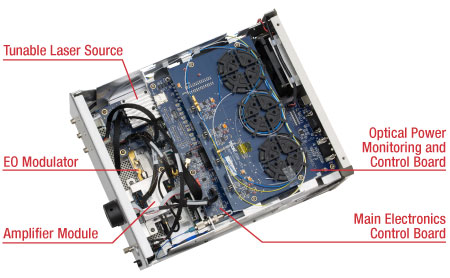
Click to Enlarge
The MX40B Digital Reference Transmitter
Design, Manufacturing, and Testing Capabilities
Thorlabs' Ultrafast Optoelectronics Team designs, develops, and manufactures high-speed components and instrumentation for a variety of photonics applications having frequency responses up to 110 GHz. Our extensive experience in high-speed photonics is supported by core expertise in RF/microwave design, optics, fiber optics, optomechanical design, and mixed-signal electronics. As a division of Thorlabs, a company with deep vertical integration and a portfolio of over 20,000 products, we are able to provide and support a wide selection of equipment and continually expand our offerings.
Our catalog and custom products include a range of integrated fiber-optic transmitters, modulator drivers and controllers, detectors, receivers, pulsed lasers, variable optical attenuators, and a variety of accessories. Beyond these products, we welcome opportunities to design and produce custom and OEM products that fall within our range of capabilities and expertise. Some of our key capabilities are:
- Detector and Receiver Design, to 70 GHz
- Fiber-Optic Transmitter Design, to 110 GHz
- RF & Microwave Design and Simulation
- Design of Fiber-Optic and Photonics Sub-Assemblies
- High-Speed Testing, to 110 GHz
- Micro-Assembly and Wire Bonding
- Hermetic Sealing of Microwave Modules
- Fiber Splicing of Assemblies
- Custom Laser Engraving
- Qualification Testing
Overview of Custom and Catalog Products
Our catalog product line includes a range of integrated fiber-optic transmitters, modulator drivers and controllers, detectors, pulsed lasers, and accessories. In addition to these, we offer related items, such as receivers and customized catalog products. The following sections give an overview of our spectrum of custom and catalog products, from fully integrated instruments to component-level modules.
Fiber-Optic Instruments
To meet a range of requirements, our fiber-optic instruments span a variety integration levels. Each complete transmitter includes a tunable laser, a modulator with driver amplifier and bias controller, full control of optical output power, and an intuitive touchscreen interface. The tunable lasers, modulator drivers, and modulator bias controllers are also available separately. These instruments have full remote control capability and can be addressed using serial commands sent from a PC.
- Fiber-Optic Transmitters, to 110 GHz
- Linear and Digital Transmitters
- Electrical-to-Optical Converters, to 110 GHz
- Modulator Drivers
- Modulator Bias Controllers
- C- and L-Band Tunable Lasers
Customization options include internal laser sources, operating wavelength ranges, optical fiber types, and amplifier types.
Fiber-Optic Components
Our component-level, custom and catalog fiber-optic products take advantage of our module design and hermetic sealing capability. Products include detectors with frequency responses up to 50 GHz, and we also specialize in developing fiber-optic receivers, operating up to and beyond 40 GHz, for instrumentation markets. Closely related products include our amplifier modules, which we offer upon request, variable optical attenuators, microwave cables, and cable accessories.
- Hermetically-Sealed Detectors, to 50 GHz
- Fiber-Optic Receivers, to 40 GHz
- Amplifier Modules
- Electronic Variable Optical Attenuators
- Microwave Cables and Accessories
Customization options include single mode and multimode optical fiber options, where applicable, and detectors optimized for time or frequency domain operation.
Free-Space Instruments
Our free-space instruments include detectors with frequency responses around 1 GHz and pulsed lasers. Our pulsed lasers generate variable-width, nanosecond-duration pulses, and a range of models with different wavelengths and optical output powers are offered. User-adjustable repetition rates and trigger in/out signals provide additional flexibility, and electronic delay-line products enable experimental synchronization of multiple lasers. We can also adapt our pulsed laser catalog offerings to provide gain-switching capability for the generation of pulses in the 100 ps range.
- Pulsed Lasers with Fixed 10 ns Pulse Duration
- Pulsed Lasers with Variable Pulse Width and Repetition Rates
- Electronic Delay Units to Synchronize NPL Series Pulsed Lasers
- Amplified Detectors
Customization options for the pulsed lasers include emission wavelength, optical output powers, and sub-nanosecond pulse widths.
| Posted Comments: | |
Lida Xu
(posted 2024-03-15 23:26:43.27) Hi Thorlabs,
We are performing pulsed lase experiments and I am wondering whether the damage threshold '200mW' is peak power or average power. Could you give me an answer? Thanks.
Lida jdelia
(posted 2024-03-21 01:52:01.0) Thank you for contacting Thorlabs. This specification was tested using a CW source. I have contacted you directly to discuss your application and whether your pulsed source may be suitable for the EVOA1550A. Dodd Gray
(posted 2024-02-15 14:31:52.687) Please make a version of this product with an analog electrical input for an external power measurement signal! This is a great tool but it is often best to use a power measurement as close as possible to your experiment for power stabilization.
The option to diverting the feedback control signal to an analog electrical output for used with, eg an AOM for higher power lasers, would also be very useful. ksosnowski
(posted 2024-02-26 12:26:04.0) Hello Dodd, thanks for reaching out to Thorlabs. Currently the EVOA does allow external analog modulation and monitoring of the photodiode in the module. However our initial intent was to simplify the application by integrating the feedback loop directly, rather than as part of the interface. It may be possible to use our standalone VOAs in a system with an existing power monitor and feedback loop though I have added your idea to our internal forum for further consideration in future designs. Junhee Park
(posted 2023-04-17 10:17:54.357) Do you have a PM fiber EOVA800A? cdolbashian
(posted 2023-04-26 08:54:25.0) Thank you for reaching out to us Junhee. At the time of posting this, it seems like this is indeed something we can make as a custom for you. I have contacted you regarding details of your custom requirement. For future custom requests, please feel free to email techsales@thorlabs.com. ZHANG Luan
(posted 2023-02-15 19:46:20.743) Hi,
I bought a EVOA1550 2 years ago. Just wonder can I use it "bi-directional". In other words, if I send light into the "output" port, can I get the attenuated light at the "input" port?
Is there an isolator inside the EVOA1550?
Look forward to your reply?
All my best,
Luan cdolbashian
(posted 2023-02-17 09:26:14.0) Thank you for reaching out to us with this inquiry Luan. Indeed, you can use this isolator in reverse, as the mems-based attenuator is bidirectional. However due to the construction internally, you wouldn't be able to monitor power or use the power-stabilization feature. There is not an isolator internally. Yutong Feng
(posted 2020-10-08 07:35:45.54) Hello, my working wavelength would be at 980 nm, could Thorlabs provide variable attenuator at 980 nm that can deal with >200 mW power? YLohia
(posted 2020-10-08 03:02:50.0) Thank you for contacting Thorlabs. Custom items can be requested by clicking on the Request Quote button above or by emailing your local Thorlabs Tech Support team (in your case techsupport.uk@thorlabs.com). We will contact you directly to discuss the feasibility of offering this. Alexandra Gerling
(posted 2020-10-01 12:08:04.093) Dear Thorlabs Team,
is this pruduct available in a PM configuration? If yes, could you send me a quote?
Kind regards,
Alexandra Gerling YLohia
(posted 2020-10-01 02:48:33.0) Hello Alexandra, thank you for contacting Thorlabs. Custom items can be requested by emailing your local Thorlabs Tech Support team (in your case, europe@thorlabs.com) or by clicking the red "Request Quote" button above. We will discuss the possibility of offering this directly. Naresh Kumar Ravichandran
(posted 2020-08-10 00:57:34.247) We recently bought EVOA15550A.
It is very convenient and the mode lock feature is quite useful.
The only down factor is that the input pulse is broadened after the attenuation.
It would be of great help if the technical team could address this. Or in the least mention the effect of pulse broadening and suggest components from thorlabs that can be used to compensate this. YLohia
(posted 2020-08-10 02:57:12.0) Hello, thank you for contacting Thorlabs. The unit contains optical components (SMF-28 fibers, GRIN lens, gold mirror) that contribute to pulse broadening. The PMDCF (dispersion compensating fiber), FSPC (femtosecond pulse compressor), and our line of chirped mirrors can be used to compensate for this effect, depending on your application and requirements. I have reached out to you directly to discuss this further. |

- In-Line Fiber Optic Power Monitor for 785 nm, 852 nm, or User-Calibrated Wavelength
- Maximum Attenuation of >25 dB
- Input Power up to 200 mW
- FC/APC and FC/PC Versions Available
These EVOAs are designed for use with optical fiber that is single mode within the operating range of the EVOA. An example of single mode optical fiber that may be used with the EVOA800 models is 780HP.

- In-Line Fiber Optic Power Monitor for 1310 nm, 1550 nm, or User-Calibrated Wavelength
- Maximum Attenuation of >25 dB
- Input Power up to 200 mW
- FC/APC and FC/PC Versions Available
These EVOAs are designed for use with optical fiber that is single mode within the operating range of the EVOA. An example of single mode optical fiber that may be used with the EVOA1550 models is SMF-28.
 Products Home
Products Home


















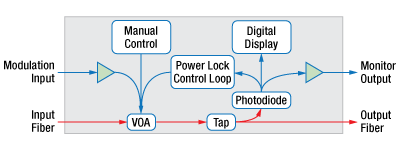
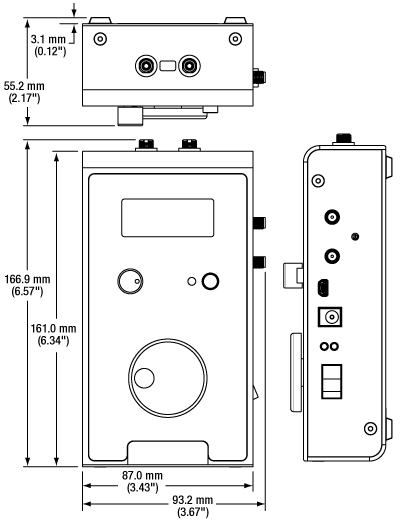











 SM Electronic VOAs with Power Lock
SM Electronic VOAs with Power Lock